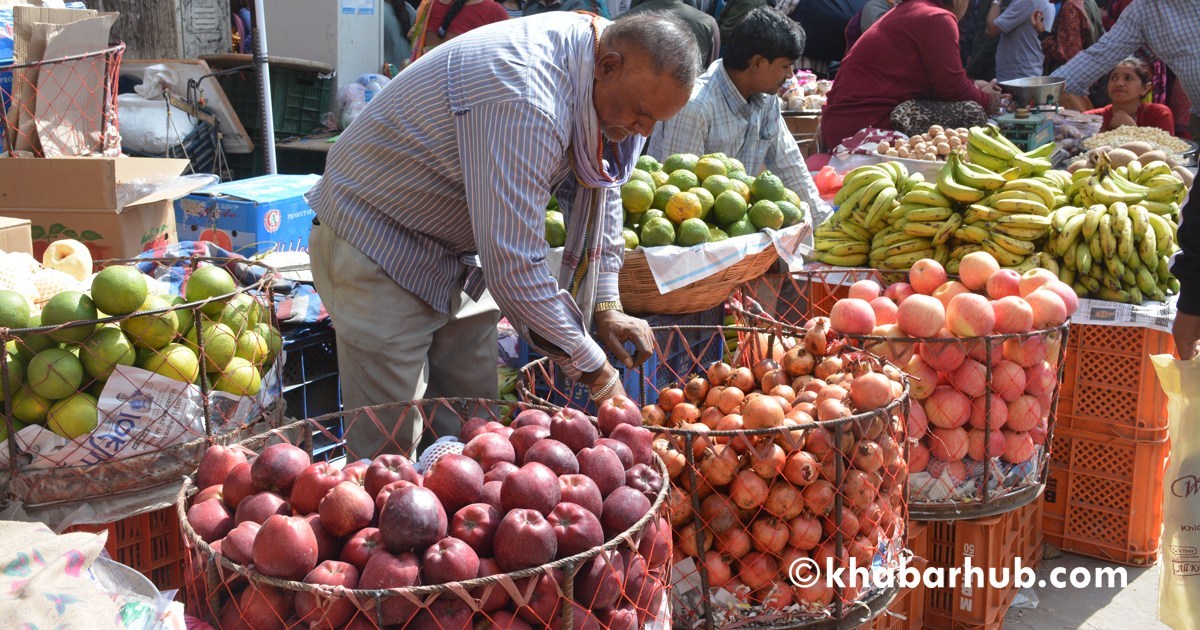KATHMANDU: Despite declarations to make the country self-reliant in fruits, the import of the fruits is still far from recessing.
The increasing demand for fruits seems beyond the coverage of the fruit production super-zones.
6 districts of Nepal Humla, Jumla, Mugu, Kalikot, Dolpa and Mustang are the main pocket zones for apple farming in Nepal. The expansion of it to other districts has not been remarkably successful yet.
Nepal imports apple worth more than 5 billion rupees every year.
Fruits worth nearly 3 billion rupees imported
Domestic product is still unable to meet the demand here. The demand for fruits goes nearly doubled on festive seasons like the months which see Dashain, Tihar, Chhath, etc.
According to the Department of Customs, the first three months of each fiscal year sees the highest import of fruits.
The Department informed that the country imported fruits worth Rs 2.77 billion in this period this year. This is nearly one billion less than the previous year. Last year, the same period had seen the import of fruits worth 3.67 billion rupees.
The statistics at the customs department reveal that the country has imported banana worth Rs 179.2 million, guava worth 5.1 million, orange worth 6.2 million and other citrus fruits worth 5.06 million in the first three months of this year.
Similarly, the apple worth Rs 1.34 billion has been imported by now. Lemonade worth 229 million and other fresh fruits worth Rs 285.5 million have also arrived in the Nepali market from outside the country.
The fruit market has not shrunk yet
Federation of Fruits and Vegetable Entrepreneurs Nepal(FWEAN) claims that the festive season gets three times more fruits and vegetables imported than in other seasons.
Despite the fact that the consumption of fruits and vegetables has slightly declined due to COVID-19, no entrepreneurs experienced the condition in which they have to throw their products.
“Although the consumption of the fruits declined slightly due to coronavirus pandemic, the consumption is not too low to make the imported goods throw or let them decay due to the decline,” Khom Prasad Ghimire, the President of FWEAN told Khabarhub, “As the trend of consuming fruits even on other days has increased, the entrepreneurs ensure the balance in the demand and supply of the fruits in the same way.”
According to Ghimire, the capital valley consumes around 400 tons of fruits every day. The number goes above 1000 tons during the festive season.
The consumption trend shows that people buy fruits more in Tihar than in Dashain.
FWEAN President Ghimire points out that fruit consumption during festivals has not shrunk despite the pandemic.
“Generally 800-1000 tons used to be consumed every day in this season, this year also it’s the same,” he said, “the fruit business has not gone down by the pandemic.”
Most of the fruits imported to Nepal are from India and China.
Price hike
Talking about the price of the fruits, it has gone slightly high this time. The banana now costs Rs 120/kg apple Rs 100-120/kg and Apple Fuji Rs. 250/kg
Likewise, the local guava is being sold at Rs 50-70/kg, orange (Indian) Rs 80/kg and pomegranate Rs. 200/kg.
According to Kashi Ram Sapkota, the Treasurer of Nepal Fruits Wholesaler Traders Association, there has been a slight rise in the price of fruits this year.
“Compared to the last year’s price, the price of fruits has gone up by 10-15 rupees this year,” Sapkota told Khabarhub adding, “The disturbance in Kerung and Tatopani border made us channel it through Calcutta, the price slightly went up.”
Nearly 15 billion spent on import of fruits
The statistics at the Department of Customs show that the country imports fruits worth nearly 15 billion.
The country spent 13.284 billion on the import of fruits in 2018/19 which saw a slight decline in 2019/20. In 2019/20, the country imported fruits worth 12.10 billion.
The record shows that banana, mango, grapes, apple, orange, lemon, and other citrus fruits are imported in large quantities every year.








Comment